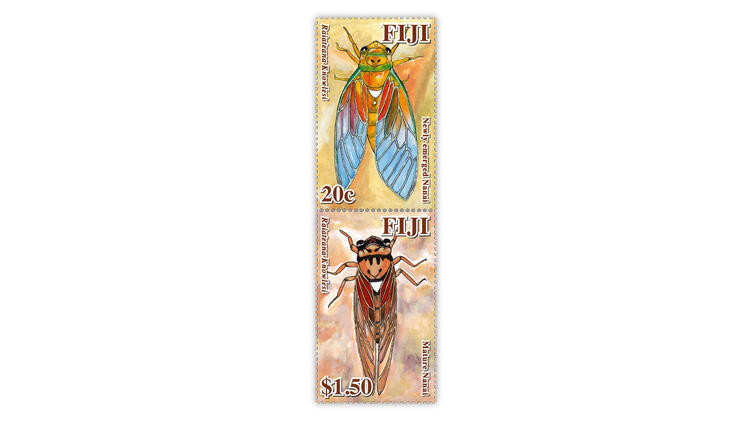World Stamps
Topical collectors seek pair of Fijian cicada stamps

Stamp Market Tips by Henry Gitner and Rick Miller
The Republic of Fiji is comprised of more than 300 islands in Melanesia in the South Pacific Ocean. About 110 of the islands have permanent inhabitants. Most of the population lives on the two main islands, Viti Levu and Vanua Levu.
Indigenous Fijians are a mixture of Austronesian and Melanesian peoples. About 37 percent of the present population of almost 900,000 are the descendants of Indian workers imported by the British.
Fiji was united as an independent kingdom from 1871 to 1874. On Oct. 10, 1874, it became a British colony, and it became a fully independent member of the British Commonwealth in 1970.
Some entomologists (people who study insects) also collect stamps, sometimes forming insect topical collections.
On June 30, 2010, Fiji issued a vertical pair of Raiateana Knowlesi stamps (Scott 1242). These insects, also known as Fijian cicadas, begin as eggs, live underground as nymphs and emerge after eight years to mature and breed and start the cycle over.
The upper 20¢ stamp in the pair shows the cicada as a newly emerged juvenile. The lower $1.50 stamp depicts a fully mature insect.
To the best of our knowledge, this is the only stamp issue that depicts this Fijian cicada, making the pair a must-have for insect topical collectors who collect cicadas.
The 2019 Scott Standard Postage Stamp Catalogue values the vertical pair at $2 in both mint never-hinged condition and used condition.
Despite being relatively inexpensive, this pair is not easy to find. If you see it offered at or near Scott catalog value, it is a very good buy.
Connect with Linn’s Stamp News:
Sign up for our newsletter
Like us on Facebook
Follow us on Twitter
MORE RELATED ARTICLES
Headlines
-
US Stamps
Oct 7, 2024, 3 PMMcMurtrie dismissed as APS education director following Sept. 21 arrest
-
US Stamps
Oct 7, 2024, 12 PMVasiliauskas named president of Mystic Stamp Co.
-
US Stamps
Oct 6, 2024, 5 PMApgar souvenir card available
-
US Stamps
Oct 6, 2024, 4 PMFirst Continental Congress and U.N. stamps receive Scott catalog numbers








